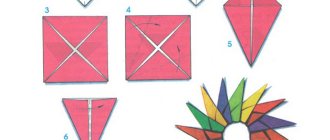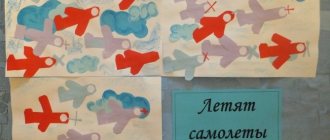Summary of a drawing lesson in the first junior group “The sun through the window”
Lyubov Ermolaeva
Summary of a drawing lesson in the first junior group “The sun through the window”
Summary of a drawing lesson in the first junior group “ Sunshine through the window ”
Goal: To teach children to draw an image of the sun , to evoke an emotional response.
Objectives: Continue to teach children through color spots, display lines and rays - the image of the sun , using red and yellow paints. Teach the correct placement of drawing details on a sheet.
Materials: Illustrations depicting the image of a cheerful sun , ready-made models ( “ windows with shutters ”
) tinted in different colors. Paints of two colors (red, yellow, brushes, jars of water, napkins.
Progress of the lesson : The teacher reads a poem about the sun . The sun extended ,
To my window ,
The teacher puts a tinted sheet on the easel ( “ window ”
, opens the shutters and the children see the image of a smiling
sun . The sun heard us , smiled, dressed up and looked out the window .” Guys, look how cheerful it is, its rays warm us, the sun smiles at us . Let's go to “
window ” and stretch out our hands to
the sun . It warmed us with red and yellow rays. Guys, do you want to draw a sun in “ window ”
The teacher invites the children to come up and choose “ window with shutters ”
.
Children choose their own windows , open them with interest and close them and see that the sun is not there . The teacher invites the children to draw the sun with paints .
On the topic: methodological developments, presentations and notes
Drawing lesson for children 2-3 years old using non-traditional means of depiction (stamps). When organizing activities, musical accompaniment is actively used, which has a positive effect.
March 8th holiday for 2nd junior group.
“The sun is shining through the window” Summary of direct educational activities with children of the first junior group OO “Artistic and Aesthetic Development” Educational areas: “Artistic and aesthetic.
Strengthen the ability to convey the image of the sun in a drawing, combining a rounded shape with straight lines.
Learning to draw round objects.
Source
Summary of a drawing lesson in the early age group “Sun”
Natalya Grigorovich
Summary of a drawing lesson in the early age group “Sun”
Goal: To maintain and develop children's interest in visual arts.
Teach children to draw the sun ; ability to answer questions; distinguish between sad and happy moods; reinforce ideas about the color yellow.
Learn to hold a brush in your hand, draw round and straight lines.
Develop creative abilities; interest in the surrounding reality; develop imagination.
To instill in children an interest in drawing , a desire to provide help to those who need it, to cultivate accuracy when doing work, and a friendly attitude towards each other.
Vocabulary work: activate the words in speech: sun , shining, rays, side, above, below.
A panel with a picture of the sun , a toy cockerel; easel, Whatman paper with painted yellow circle; brushes, yellow gouache, napkins, rags
Preliminary work: Reading poems about the sun , nursery rhymes; looking at the sun while walking , and looking at pictures. Drawing round objects.
Educator: Look, today we have a lot of guests, let's say hello to them. Hello!
We will clap first: (clap hands)
And then we will stomp: (stomping feet)
And now we will turn around (circle)
And let's smile at each other (smile)
(The teacher shows the toy Cockerel)
.
- Look who came to us? (children's answers)
— In the morning he woke up and didn’t see the sun . Don’t be sad cockerel, we will help you. Let's help the cockerel, call the sun ?
is looking through the window ,
It shines into our room.
We will clap our hands:
We are very happy about the sun .
Educator: What is this, children?
Children: Sunny .
Educator: Look how light it has become in our group . Do you know, why?
Children: The sun .
Educator: How does this make you feel?
Children: Cheerful, joyful.
Educator: What is our sunshine mood?
Children: The sun is smiling .
Educator: Let's show how the sun . (Show)
.
Educator: What is the shape of the sun ?
Educator: What else does the sun ? (Rays)
.
's rays are straight , like our hands. Only we have two hands, and the sun has many rays . 's rays are everywhere : from the side, from above, from below, to warm everyone up.
And guys, flowers, butterflies, trees. (Invite the children to sit at the easel)
.
Educator: Let's draw suns .
(The teacher draws the sun and rays , calling the children to him)
This is what kind, beautiful sun we got .
Physical school
.
The night looked through the window, (Children cup their hands)
Our sun has fallen asleep (Tilt their head)
.
Educator: Now go to the tables and you will draw the sun . And the cockerel will sit here and watch how you draw .
(Children sit at tables)
.
Educator: First, let us all draw the sun in the air .
(Children draw a circle in the air with a brush together with the teacher)
.
Educator: Now take the brush in your right hand, dip it in water, blot excess water on a napkin, and take paint on the brush and draw a circle.
Educator: Well done! sun missing ? That's right, rays! Let's add some rays to it! What color will the rays of our sun ? the sun itself !
MAGAZINE Preschooler.RF
Summary of direct educational drawing activities on the topic: “Rain” for children of the second junior group Maria Smetankina, teacher of the second junior group MBDOU d/s No. 5 “Wave” Anapa 2013 Goal: development of artistic and aesthetic feelings through play activities Objectives: Teach rhythmically , apply strokes when depicting rain, placing them throughout the sheet, find the similarity of strokes with raindrops; develop pencil drawing skills. Create conditions for the development of oral speech components in various activities. Develop memory, attention, imagination, emotions, logical thinking; Develop aesthetic perception; Creative skills. Cultivate a desire to work; Establishing cause-and-effect relationships. Preliminary work: Creation of a subject-development environment. Watching an animated film: “Funny Garden” “Rain” Reading fiction: Looking at the illustration “Autumn” Observing the rain. Outdoor game: “Sun and Rain.” Vocabulary work: objects: rain, cloud, thunder, wind. actions of objects: drips, rattles, rumbles, blows Signs of objects: cold, damp, autumn. Equipment: easel, pencils, paper with painted clouds. Pictures depicting clothes (jacket, umbrella, rubber boots, slippers, hat, trousers). ICT: audio recording of the sounds of pouring rain and thunder, cartoon “Merry Garden”. Handouts: blue pencils, paper, trays with semolina cereals GCD procedure 1. Organizational moment (an audio recording of the sounds of pouring rain and thunder sounds). Educator: Guys, tell me, what do you hear? Children: Rain is falling, thunder is roaring. Educator: Do you like rainy weather? Children: No. Educator: Why? 2. Main part: (Children's answers) Educator: Please watch an excerpt from the cartoon “The Cheerful Vegetable Garden,” an episode where the vegetable garden dries up and rain comes to the rescue. Tell me, why do we need rain? Children: Trees, grass, flowers, vegetables need rain. Educator: Yes, and we have so much fun walking through the puddles if we dress for the weather. The teacher invites the children to compose an algorithm; the children are presented with pictures depicting clothes (jacket, umbrella, rubber boots, slippers, hat, trousers) Educator: Look carefully and choose the clothes that we will wear for a walk. Children: Make a choice and lay out the algorithm on the board. 3. Physical exercise “Rain” Teacher: Oh, guys! A cloud rolled in and it began to rain! Children tap their fingers on the floor or table. A thunderstorm flashed. They knock with their palms. Thunder rumbled. Children bang their fists. The rain began to subside and stopped completely. Gradually the rhythm slows down. During the exercise, the teacher can set the rhythm using a metallophone. “Rain, pour harder.” Rain clouds have arrived. Rain, rain, rain! Arms extended, palms down. The raindrops are dancing, shaking their arms, stamping their feet. Like the living, Drink, rye, drink! And the rye, bending towards the green earth, drinks, drinks, drinks, and the warm rain does not stop pouring, pouring, pouring! 4. Practical part Drawing. "It's raining". Educator: Now look, in my drawing it hasn’t started raining yet, although the clouds have already covered the sun. And then the first drops of rain fell to the ground. Drip-drip, drip-drip. (The teacher rhythmically makes strokes with a pencil, now speeding up, now slowing down.) The rain is getting quieter and has completely stopped, only puddles remain on the ground. The teacher invites the children to practice drawing techniques on cereals. Each child is given a tray of semolina. The task is to rhythmically apply small strokes on the tray with your index finger. Educator: What kind of rain will there be in your drawings? Work continues on a piece of paper with a pencil. Children draw raindrops, accompanying the drawing with the words: “Drip, drip, drip...”. During the process, the teacher controls how they hold the pencil, helping children who have difficulty completing the task. 5. Final part At the end of the work, the drawings are displayed on the stand, the teacher and children find drawings depicting a strong “Oh, what a heavy rain in the drawings of ...!” and light rain “And here the rain is very light. Soon the sun will peek out from behind the clouds” (outdoor game “Sun and Rain”)| Next > |


